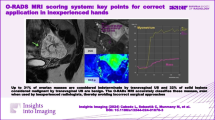Abstract
Purpose
To evaluate the characteristics of gallbladder polyps 10 mm or larger to predict a neoplasm in US examinations.
Materials and methods
Fifty-three patients with gallbladder polyps ≥ 10 mm with follow-up images or pathologic diagnosis were included in the retrospective study. All images and reports were reviewed to determine the imaging characteristics of gallbladder polyps. Univariate and multivariate analyses were used to evaluate predictors for a neoplastic polyp.
Results
A neoplastic polyp was verified in 12 of 53 patients and the mean size was 13.9 mm. The univariate analysis revealed that adjacent gallbladder wall thickening, larger size (≥15 mm), older age (≥57 years), absence of hyperechoic foci in a polyp, CT visibility, sessile shape, a solitary polyp, and an irregular surface were significant predictors for a neoplastic polyp. In the multivariate analysis, larger size (≥15 mm) was a significant predictor for a neoplastic polyp.
Conclusion
A polyp size ≥15 mm was the strongest predictor for a neoplastic polyp with US. The hyperechoic foci in a polyp and CT visibility would be useful indicators for the differentiation of a neoplastic polyp, in addition to the established predictors.
Key Points
• A polyp size ≥15 mm is the strongest predictor for a neoplastic polyp with US.
• Hyperechoic foci in a polyp and CT visibility are new predictors.
• The rate of malignancy is low in polyps even 10 mm or larger (15.1 %).




Similar content being viewed by others
References
Myers RP, Shaffer EA, Beck PL (2002) Gallbladder polyps: epidemiology, natural history and management. Can J Gastroenterol 16:187–194
Segawa K, Arisawa T, Niwa Y et al (1992) Prevalence of gallbladder polyps among apparently healthy Japanese: ultrasonographic study. Am J Gastroenterol 87:630–633
Lee KF, Wong J, Li JC, Lai PB (2004) Polypoid lesions of the gallbladder. Am J Surg 188:186–190
Gourgiotis S, Kocher HM, Solaini L, Yarollahi A, Tsiambas E, Salemis NS (2008) Gallbladder cancer. Am J Surg 196:252–264
Furlan A, Ferris JV, Hosseinzadeh K, Borhani AA (2008) Gallbladder carcinoma update: multimodality imaging evaluation, staging, and treatment options. AJR Am J Roentgenol 191:1440–1447
Cho JH, Park JY, Kim YJ et al (2009) Hypoechoic foci on EUS are simple and strong predictive factors for neoplastic gallbladder polyps. Gastrointest Endosc 69:1244–1250
Sadamoto Y, Oda S, Tanaka M et al (2002) A useful approach to the differential diagnosis of small polypoid lesions of the gallbladder, utilizing an endoscopic ultrasound scoring system. Endoscopy 34:959–965
Song HL, Shin JH, Kim H et al (2012) Clinical and radiologic preoperative predicting factors for GB cholesterol polyp. J Korean Surg Soc 82:232–237
Choi JH, Yun JW, Kim YS et al (2008) Pre-operative predictive factors for gallbladder cholesterol polyps using conventional diagnostic imaging. World J Gastroenterol 14:6831–6834
Park JK, Yoon YB, Kim YT et al (2008) Management strategies for gallbladder polyps: is it possible to predict malignant gallbladder polyps? Gut Liver 2:88–94
Cha BH, Hwang JH, Lee SH et al (2011) Pre-operative factors that can predict neoplastic polypoid lesions of the gallbladder. World J Gastroenterol 17:2216–2222
Lee J, Yun M, Kim KS, Lee JD, Kim CK (2012) Risk stratification of gallbladder polyps (1-2 cm) for surgical intervention with 18F-FDG PET/CT. J Nucl Med 53:353–358
Andren-Sandberg A (2012) Diagnosis and management of gallbladder cancer. N Am J Med Sci 4:293–299
Cairns V, Neal CP, Dennison AR, Garcea G (2012) Risk and Cost-effectiveness of Surveillance Followed by Cholecystectomy for Gallbladder Polyps. Arch Surg 147:1078–1083
Corwin MT, Siewert B, Sheiman RG, Kane RA (2011) Incidentally detected gallbladder polyps: is follow-up necessary?--Long-term clinical and US analysis of 346 patients. Radiology 258:277–282
Donald G, Sunjaya D, Donahue T, Hines OJ (2013) Polyp on Ultrasound: Now What? The Association between Gallbladder Polyps and Cancer. Am Surg 79:1005–1008
Konstantinidis IT, Bajpai S, Kambadakone AR et al (2012) Gallbladder lesions identified on ultrasound. Lessons from the last 10 years. J Gastrointest Surg 16:549–553
Sarkut P, Kilicturgay S, Ozer A, Ozturk E, Yilmazlar T (2013) Gallbladder polyps: factors affecting surgical decision. World J Gastroenterol 19:4526–4530
Sugiyama M, Xie XY, Atomi Y, Saito M (1999) Differential diagnosis of small polypoid lesions of the gallbladder: the value of endoscopic ultrasonography. Ann Surg 229:498–504
Park KW, Kim SH, Choi SH, Lee WJ (2010) Differentiation of nonneoplastic and neoplastic gallbladder polyps 1 cm or bigger with multi-detector row computed tomography. J Comput Assist Tomogr 34:135–139
Acknowledgements
The scientific guarantor of this publication is Jeong Kyong Lee. The authors of this manuscript declare no relationships with any companies, whose products or services may be related to the subject matter of the article. The authors state that this work has not received any funding. One of the authors has significant statistical expertise. Institutional Review Board approval was obtained. Written informed consent was waived by the Institutional Review Board. Study subjects or cohorts have not been previously reported. Methodology: retrospective, cross sectional study, performed at one institution.
Author information
Authors and Affiliations
Corresponding author
Rights and permissions
About this article
Cite this article
Kim, J.S., Lee, J.K., Kim, Y. et al. US characteristics for the prediction of neoplasm in gallbladder polyps 10 mm or larger. Eur Radiol 26, 1134–1140 (2016). https://doi.org/10.1007/s00330-015-3910-1
Received:
Revised:
Accepted:
Published:
Issue Date:
DOI: https://doi.org/10.1007/s00330-015-3910-1




